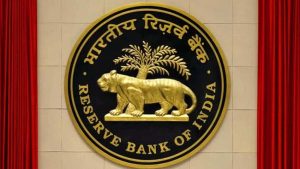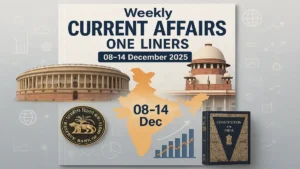
RBI Repo Rate: The decision of RBI Governor Shaktikanta Das headed the six-member Monetary Policy Committee (MPC) has been announced. The Reserve Bank of India (RBI) has hiked the repo rate by 50 basis points to 5.90%, the fourth straight increase in the current cycle, to tame the sustained above-target retail inflation rate. RBI had slashed the repo rate in March 2020 with an aim to cushion the impact of covid-induced lockdown and maintained the status quo in the benchmark interest rate for almost two years before increasing it on May 4, 2022.
Notably:
- The Monetary Policy Committee (MPC) met on the 28th, 29th and 30th of September 2022.
- The next meeting of the MPC is scheduled during December 5-7, 2022.
RBI Repo Rate: Consequently, the various rates are as under
- Policy Repo Rate: 5.90%
- Standing Deposit Facility (SDF): 5.65%
- Marginal Standing Facility Rate: 6.15%
- Bank Rate: 6.15%
- Fixed Reverse Repo Rate: 3.35%
- CRR: 4.50%
- SLR: 18.00%
RBI Repo Rate: Key Points of the Monetary Policy
- Reserve Bank of India leaves inflation projection for FY23 unchanged at 6.7% on upside risks to food prices.
- The RBI has lowered the real gross domestic product (GDP) growth forecast for FY23 to 7% from 7.2%. Q2FY23 growth is seen at 6.3%, Q3 at 4.6% and Q4 at 4.6% with risks broadly balanced. Growth for Q1FY24 has been revised to 7.2%.
- In the August policy, the RBI had left the inflation projection for this fiscal unchanged at 5.7%, despite acknowledging that inflation had peaked.
- Sensex declines 262.73 points to 56,147.23 ahead of the MPC meet
- Rupee rises 14 paise to 81.59 against the US dollar in early trade
- The trade deficit remained near all-time highs in July and August and the current account deficit is expected to track near a 10-year high of 5 per cent of gross domestic product (GDP).
- The 28-day VRRR auction merged with a 14-day VRRR auction. VRRR stands for variable rate reverse repo (VRRR) auctions.
- The average crude oil price (Indian basket) was revised to US$100 per barrel from US$105 earlier as global crude prices fell.
- Forex have shrunk nearly $100 billion to $545 billion from a peak of $642 billion a year ago and are expected to fall further.
RBI Repo Rate: The Monetary Policy Committee
Section 45ZB of the amended RBI Act, 1934 provides for an empowered six-member monetary policy committee (MPC) to be constituted by the Central Government by notification in the Official Gazette. The first such MPC was constituted on September 29, 2016. The present MPC members, as notified by the Central Government in the Official Gazette of October 5, 2020, are as under:
- Governor of the Reserve Bank of India—Chairperson, ex officio;
- Deputy Governor of the Reserve Bank of India, in charge of Monetary Policy—Member, ex officio;
- One officer of the Reserve Bank of India to be nominated by the Central Board—Member, ex officio;
- Prof. Ashima Goyal, Professor, Indira Gandhi Institute of Development Research —Member;
- Prof. Jayanth R. Varma, Professor, Indian Institute of Management, Ahmedabad—Member; and
- Dr. Shashanka Bhide, Senior Advisor, National Council of Applied Economic Research, Delhi—Member.
(Members referred to at 4 to 6 above, will hold office for a period of four years or until further orders, whichever is earlier)
RBI Repo Rate: What is the role of MPC?
- The MPC determines the policy repo rate required to achieve the inflation target.
- The MPC is required to meet at least four times in a year. The quorum for the meeting of the MPC is four members.
- Each member of the MPC has one vote, and in the event of an equality of votes, the Governor has a second or casting vote.
- Each Member of the Monetary Policy Committee writes a statement specifying the reasons for voting in favour of, or against the proposed resolution.
RBI Repo Rate: Instruments of Monetary Policy
There are several direct and indirect instruments that are used for implementing monetary policy.
Repo Rate: The interest rate at which the Reserve Bank provides liquidity under the liquidity adjustment facility (LAF) to all LAF participants against the collateral of government and other approved securities.
Standing Deposit Facility (SDF) Rate: The rate at which the Reserve Bank accepts uncollateralised deposits, on an overnight basis, from all LAF participants. The SDF is also a financial stability tool in addition to its role in liquidity management. The SDF rate is placed at 25 basis points below the policy repo rate. With introduction of SDF in April 2022, the SDF rate replaced the fixed reverse repo rate as the floor of the LAF corridor.
Marginal Standing Facility (MSF) Rate: The penal rate at which banks can borrow, on an overnight basis, from the Reserve Bank by dipping into their Statutory Liquidity Ratio (SLR) portfolio up to a predefined limit (2 per cent). This provides a safety valve against unanticipated liquidity shocks to the banking system. The MSF rate is placed at 25 basis points above the policy repo rate.
Liquidity Adjustment Facility (LAF): The LAF refers to the Reserve Bank’s operations through which it injects/absorbs liquidity into/from the banking system. It consists of overnight as well as term repo/reverse repos (fixed as well as variable rates), SDF and MSF. Apart from LAF, instruments of liquidity management include outright open market operations (OMOs), forex swaps and market stabilisation scheme (MSS).
LAF Corridor: The LAF corridor has the marginal standing facility (MSF) rate as its upper bound (ceiling) and the standing deposit facility (SDF) rate as the lower bound (floor), with the policy repo rate in the middle of the corridor.
Main Liquidity Management Tool: A 14-day term repo/reverse repo auction operation at a variable rate conducted to coincide with the cash reserve ratio (CRR) maintenance cycle is the main liquidity management tool for managing frictional liquidity requirements.
Fine Tuning Operations: The main liquidity operation is supported by fine-tuning operations, overnight and/or longer tenor, to tide over any unanticipated liquidity changes during the reserve maintenance period. In addition, the Reserve Bank conducts, if needed, longer-term variable rate repo/reverse repo auctions of more than 14 days.
Reverse Repo Rate: The interest rate at which the Reserve Bank absorbs liquidity from banks against the collateral of eligible government securities under the LAF. Following the introduction of SDF, the fixed rate reverse repo operations will be at the discretion of the RBI for purposes specified from time to time.
Bank Rate: The rate at which the Reserve Bank is ready to buy or rediscount bills of exchange or other commercial papers. The Bank Rate acts as the penal rate charged on banks for shortfalls in meeting their reserve requirements (cash reserve ratio and statutory liquidity ratio). The Bank Rate is published under Section 49 of the RBI Act, 1934. This rate has been aligned with the MSF rate and, changes automatically as and when the MSF rate changes alongside policy repo rate changes.
Cash Reserve Ratio (CRR): The average daily balance that a bank is required to maintain with the Reserve Bank as a per cent of its net demand and time liabilities (NDTL) as on the last Friday of the second preceding fortnight that the Reserve Bank may notify from time to time in the Official Gazette.
Statutory Liquidity Ratio (SLR): Every bank shall maintain in India assets, the value of which shall not be less than such percentage of the total of its demand and time liabilities in India as on the last Friday of the second preceding fortnight, as the Reserve Bank may, by notification in the Official Gazette, specify from time to time and such assets shall be maintained as may be specified in such notification (typically in unencumbered government securities, cash and gold).
Open Market Operations (OMOs): These include outright purchase/sale of government securities by the Reserve Bank for injection/absorption of durable liquidity in the banking system.
Find More News on Economy Here




 Weekly Current Affairs One Liners 08th t...
Weekly Current Affairs One Liners 08th t...
 Which Indian City is Known as the Footwe...
Which Indian City is Known as the Footwe...
 Which Desert is known as the Cold Desert...
Which Desert is known as the Cold Desert...







